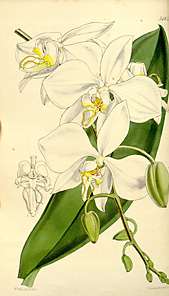Modish Moth Orchid
By Audrey Stallsmith

. . .a branch of the moth orchid, which grows on the limestone rocks of the Philippine islands, looks like a crowd of downy, spotted moths about to fly away.
"Marvels in Glass Flowers" by Ella Mosby
Most of my moth orchids (Phalaenopsis spp) are either in bloom or bud at the moment. I didn’t bring them indoors until about mid-October, and the cooler fall temperatures always seem to spur them into action.
The moth orchids—sometimes also called ice cube orchids!—are the types you see for sale in supermarkets and department stores. I’ve never tried watering mine with ice, but the reason they are so popular is that they are very well adapted to the conditions of the average home.
Most of them, in fact, are descended from a wild species called Phalaenopsis amabilis. Although amabilis actually means “lovely,” it sounds like “amiable,” and these orchids are easy to please. Phalaenopsis derives from the Greek phalaina (“moth”) and opsis (“resembling” or “like”).
Although Phalaenopsis amabilis was originally discovered in the mid 1700’s by a man whose name I have lost, it was introduced to the horticultural world in the mid 1800’s by Thomas Lobb, who was doing some orchid hunting for the house of Veitch. It proved so popular that the London Horticultural Society ordered their own explorer, Robert Fortune, to find some—which he shortly did in the Philippines.
In the wild the moth orchid generally attaches itself to either rain forest trees or rocks with its fleshy roots, and is native to parts of southeast Asia, New Guinea, and Australia. Although most of the hybrids sold today seem to have about five broad and plain green leaves, a few of the species types such as Phalaenopsis stuartiana and schilleriana boast mottled foliage.
Because amabilis’s 3-inch flowers are, indeed, very moth-like—being mostly white but definitely not downy--Phalaenopsis sanderiana and schilleriana were eventually added to the mix to produce pink shades. The hybridizing started in the late 1800’s, picked up steam in the early part of the 20th century, and hasn’t let up since. Many of the modern types boast multi-colored blooms at least 5 inches across.
Since they originally grew under the rain forest canopy, moth orchids don’t require lots of light. In fact, they are apt to be burned by direct sunlight, a fact I discover again every fall when the sun gets low enough in the south to reach under the eaves of our porch.
They are usually grown in either moss or chopped bark and don’t need frequent watering. The friend who got me started with orchids advised that I only water them about once every three days, and some experts make that once a week instead. They are more likely to die from overwatering than under watering, especially if left in their cache pots, those containers without holes into which their pots are sometimes inserted.
I’ve discovered the hard way that their roots will rot very quickly if they sit in water, so I usually remove the cache pots and place the orchids on trays of gravel under a fluorescent grow light instead. The blooms can last for weeks if they aren’t pollinated, which is why they will often seem to hold up better indoors where there are—hopefully!—fewer bugs.
Orchids stood for both “beauty” and “luxury” in the language of flowers, and the moth type can be expensive when in bloom, usually running between $10 and $15 dollars, I generally wait to buy them until after the flowers wither and they have been marked down to half price. Of course, that usually means I don’t know what color they are until they bloom again, but that makes for the most pleasant of surprises!
Phalaenopsis amabilis image is by Walter Hood Fitch, from Curtis's Botanical Magazine, Volume 86, courtesy of Wikimedia Commons.








